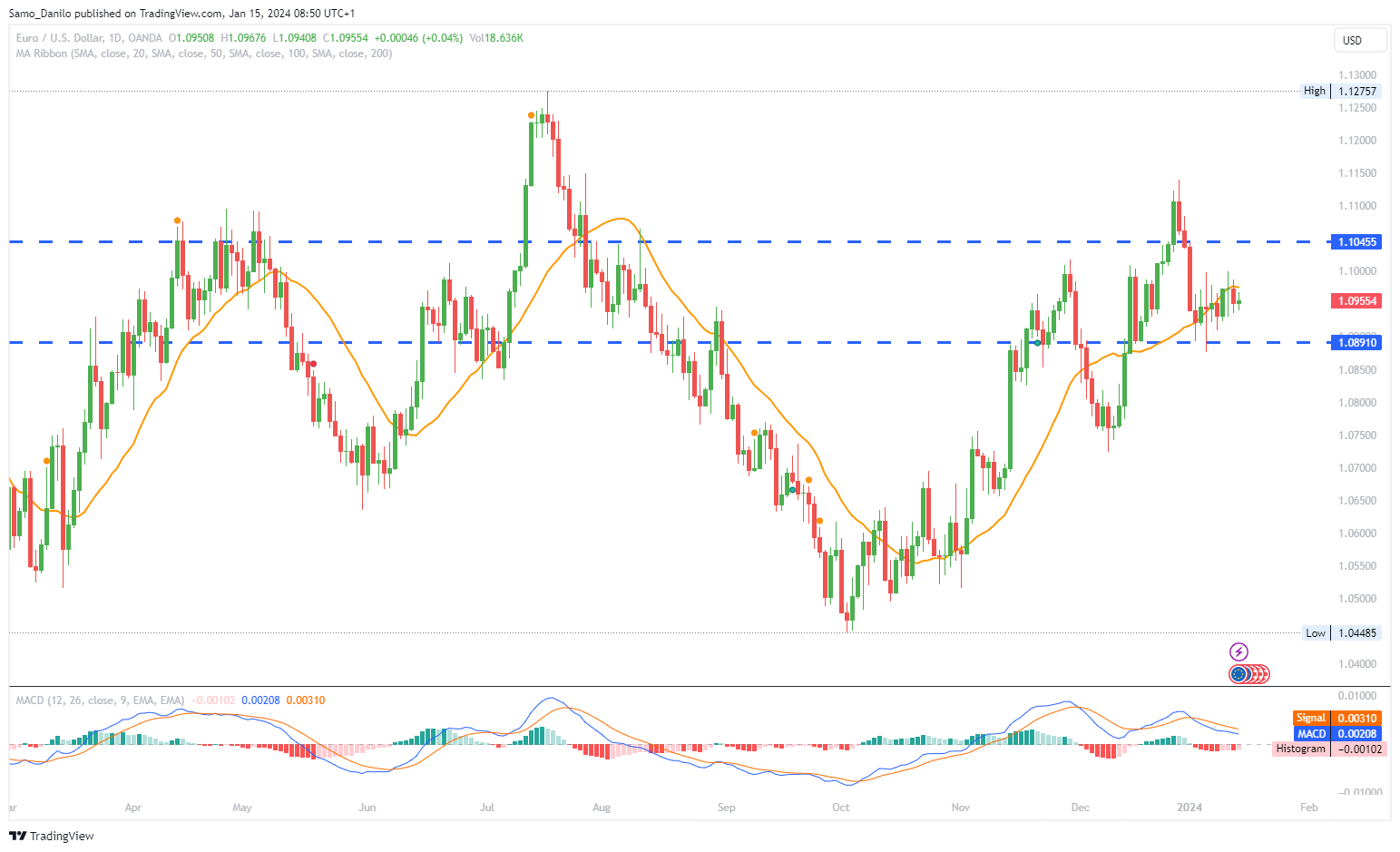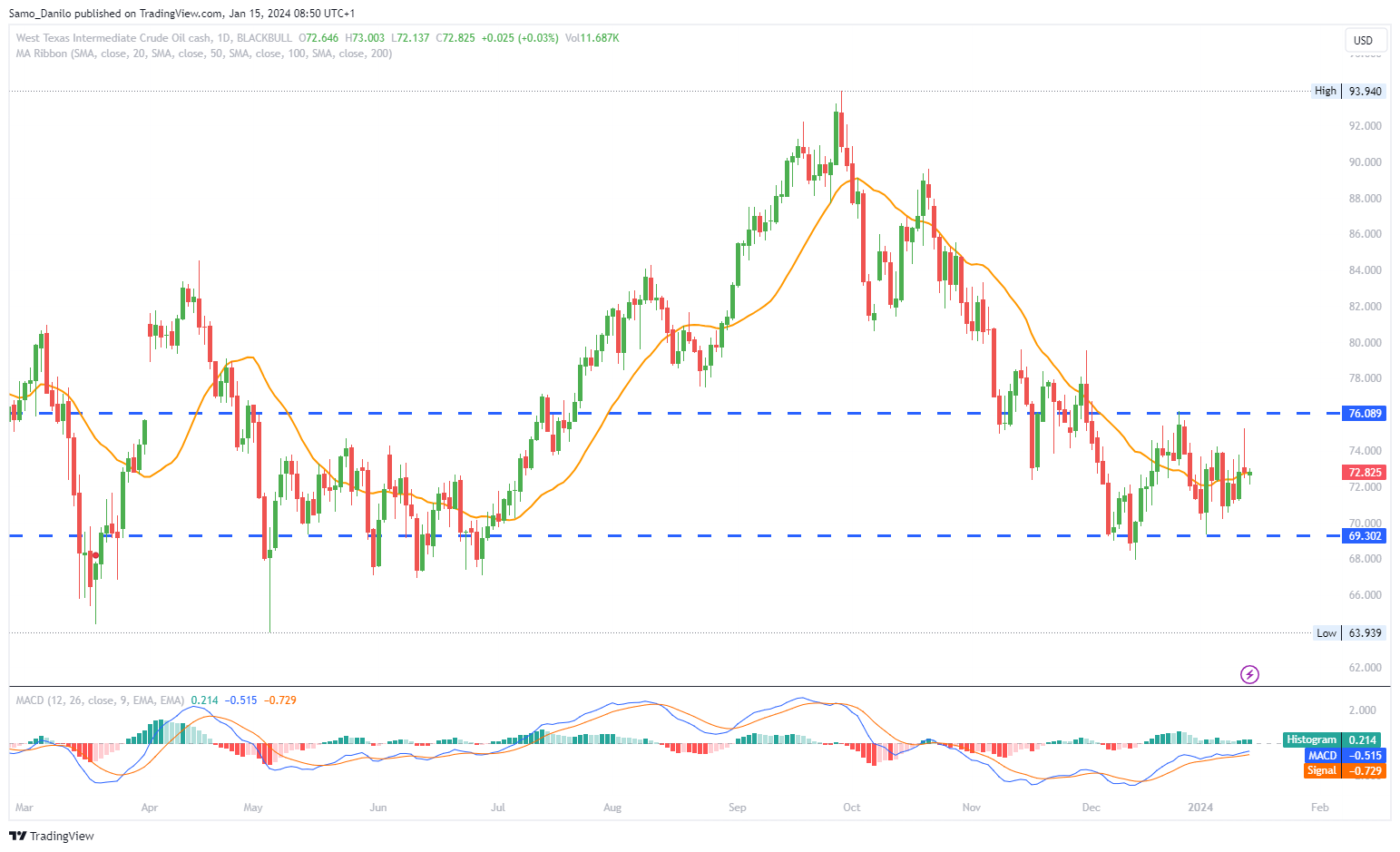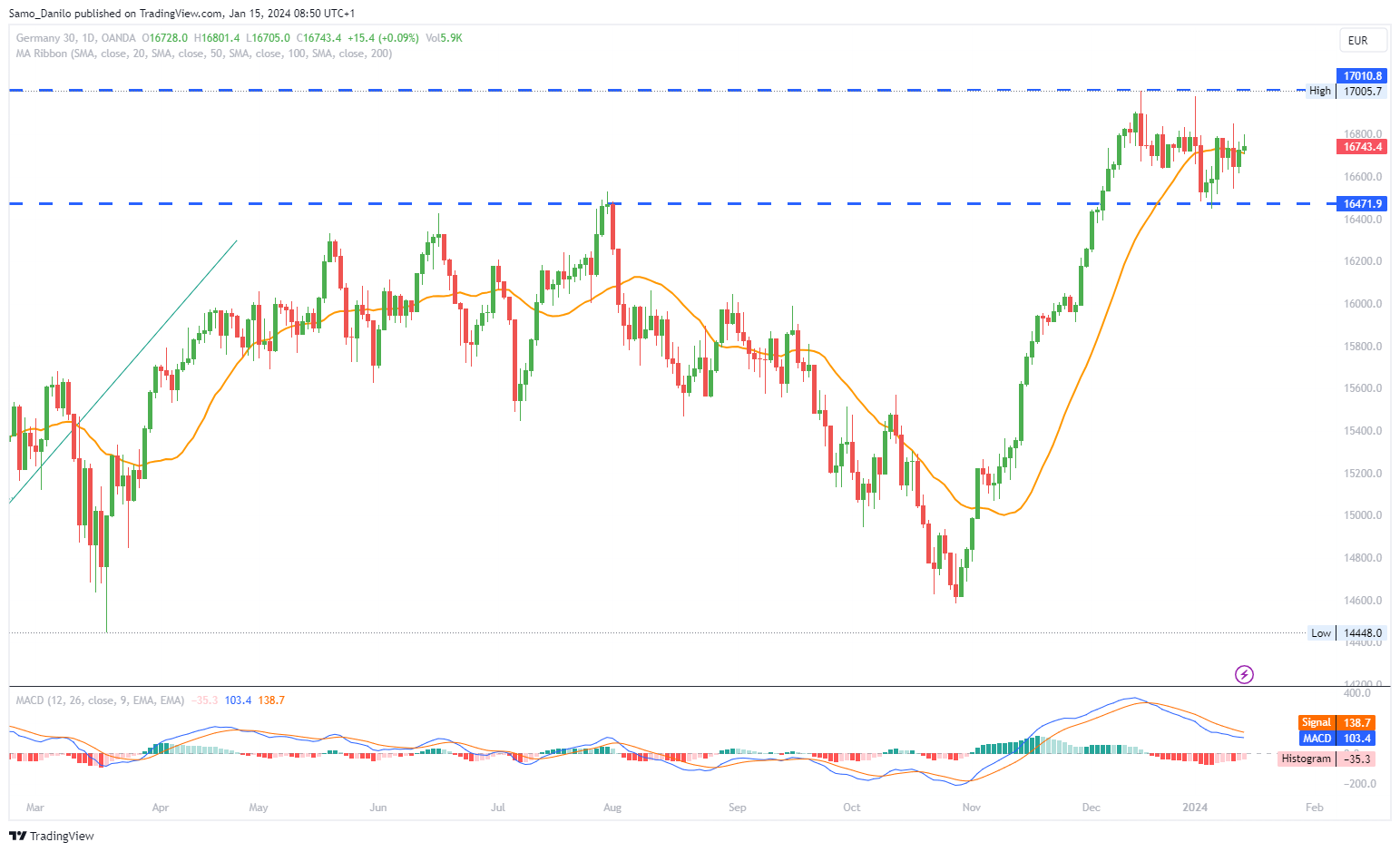EURUSD
- On Friday, the EUR/USD remained within Thursday's trading range of 1.0930-1.1000. This suggests a lack of significant directional movement during the Friday trading session. Trading ranges can be influenced by a variety of factors, including economic indicators, central bank announcements, and market sentiment.
- The upside for EUR/USD remained capped as the European Central Bank (ECB) announced an end to the elongated rate-tightening regime. Changes in monetary policy, especially from major central banks like the ECB, can have a profound impact on currency pairs.
- The pair found support from stubbornly higher consumer price inflation in the United States. Inflation dynamics in major economies, especially the U.S., play a crucial role in shaping expectations regarding central bank policies and can influence currency pairs.
- On Monday, the EUR/USD continues to trade listlessly inside Friday's range. This can be attributed to an extended weekend in the U.S. economy due to Martin Luther King Birthday, leading to reduced market activity and participation.
- Despite a surprisingly softer US Producer Price Index (PPI) report for December, the EUR/USD struggled to gain traction. Economic indicators, especially those related to inflation, are closely monitored by traders for their potential impact on currency pairs.
- Looking ahead, market participants are keenly focused on the monthly US Retail Sales data for December. Investors are projecting that consumer spending rose at a higher pace of 0.4%, compared to 0.3% growth in November. Retail sales data is a key economic indicator, reflecting consumer confidence and spending patterns.
Closing statement: EUR/USD exhibited a consolidative trading range on Friday and Monday, influenced by factors such as the ECB's policy announcement and U.S. inflation dynamics. The extended U.S. weekend contributed to listless trading on Monday. Despite a softer U.S. PPI report, the pair struggled to find a clear direction. The upcoming focus on U.S. Retail Sales data will likely provide further insights into economic conditions and impact EUR/USD.
GBPUSD
- GBP/USD is experiencing a period of consolidation near the 1.2750 level in the European morning on Monday. This area is identified as a resistance zone, coinciding with the 61.8% Fibonacci retracement traced back from June 2021. Such technical levels can be significant in influencing trader behavior.
- The US Dollar might have faced downward pressure on Friday due to softer-than-expected Producer Price Index (PPI) data. Economic indicators, especially those related to inflation, can impact currency movements.
- The GBP/USD pair might have gained ground on improved production data from the United Kingdom released on Friday. Economic indicators reflecting the health of the UK economy, such as production data, can influence the British Pound.
- On Monday, January's Rightmove House Price Index (MoM) improved by 1.3%, reversing the previous decline of 1.9%. Housing market indicators, like house price indices, can be important for understanding economic sentiment.
- Traders are likely to observe labor market data later in the week, including Claimant Count Change and ILO Unemployment Rate (3M). Labor market indicators provide insights into the economic health of a country and can impact currency pairs.
| SMA (20) | Rising |
|
|
| RSI (14) | Slightly Rising |
| |
| MACD (12, 26, 9) | Slightly Falling |
|
Closing statement: GBP/USD is in a consolidation phase around the 1.2750 level, influenced by technical factors and recent economic data. The pair may have benefited from softer-than-expected PPI data in the US and improved UK production data. Positive figures in the Rightmove House Price Index contribute to the overall market sentiment. Traders are anticipated to closely watch upcoming labour market data for further cues on the economic health of the UK.
GOLD
- Gold price continues to capitalize on persisting uncertainty in the market as investors assess the latest fundamental developments at the beginning of the week on Monday. Gold is often considered a safe-haven asset, and its demand tends to increase during times of uncertainty.
- On Friday, the US Dollar slipped from higher levels after the US Producer Price Index (PPI) unexpectedly fell in December. This event contributed to increasing bets on a Federal Reserve (Fed) rate cut in March, leading to a decline in US Treasury bond yields. Changes in interest rate expectations can impact the attractiveness of non-interest-bearing assets like gold.
- Market pricing now indicates a 78% chance that the US central bank will begin easing rates in March, compared to a 68% chance a week ago, according to the CME Group’s FedWatch tool. Such expectations can influence investor behavior and impact gold prices.
- Simmering tensions between China and Taiwan are keeping investors on edge, contributing to an overall environment of uncertainty. Geopolitical events can drive investors towards safe-haven assets like gold.
- The main focus this week remains on Fed Governor Christopher Waller’s speech, US Retail Sales data, and Chinese quarterly GDP numbers. These events can provide further insights into the economic landscape and influence gold prices.
| SMA (20) | Rising |
|
|
| RSI (14) | Rising |
|
|
| MACD (12, 26, 9) | Falling |
|
|
Closing statement: Gold price continues to benefit from market uncertainty, driven by factors such as the unexpected fall in the US PPI, increasing bets on a Fed rate cut, and geopolitical tensions. The focus for the week includes key events like Fed speeches and economic data releases that can impact the overall market sentiment and influence gold's price direction.
CRUDE OIL
- West Texas Intermediate (WTI) price is attempting to move on an upward trajectory, trading near $72.90 per barrel during the Asian session on Monday. Oil prices are sensitive to geopolitical events and supply concerns, impacting their movement.
- Crude oil prices could potentially experience further gains due to concerns over the escalation of the Israel-Gaza conflict. Speculation about potential disruptions to oil shipments, particularly in the Strait of Hormuz, is contributing to market uncertainties.
- The Iran-led Houthis fired an anti-ship cruise missile at the USS Laboon in the Red Sea on Monday, raising tensions in the region. Traders are monitoring potential impacts on shipments and awaiting Iran's response to the situation.
- US President Joe Biden expressed concern about the potential impact of the war in the Middle East on oil prices.
- Protesters in Libya threatened to close down two additional oil and gas facilities, following the shutdown of the Sharara field on January 7. Disruptions in oil production can influence global oil prices.
| SMA (20) | Neutral | |
| RSI (14) | Neutral | |
| MACD (12, 26, 9) | Slightly Rising |
|
Closing statement: WTI price is responding to geopolitical tensions, particularly the escalation of the Israel-Gaza conflict and the Houthi missile attack. Concerns about potential disruptions to oil shipments, along with protests in Libya, are contributing to a volatile oil market. Traders will continue to monitor geopolitical developments for their impact on oil supply and prices.
DAX
- On Thursday, ECB President Lagarde's comments raised bets on ECB rate cuts. She suggested that if the fight against inflation is successful and inflation stabilizes at 2%, interest rates could start to go down. Such statements can influence market expectations regarding monetary policy.
- There were no significant economic indicators from Germany on Friday that could impact buyer demand for DAX-listed stocks. However, global factors and central bank commentary often play a role in market sentiment.
- On Friday, US producer prices fell by 0.1% in December, signaling a softer inflation outlook. This supported rising bets on a Fed rate cut in March. Changes in global economic conditions, especially in major economies like the US, can affect investor sentiment in European markets.
- On Monday, the German economy will be in the spotlight with the release of wholesale prices and Q4 GDP numbers. Economic indicators from major economies, especially Germany, can influence investor confidence in European markets.
- ECB President Christine Lagarde is also scheduled to speak on Monday. Investors will be attentive to any further comments or indications regarding the ECB's policy outlook. Dovish comments could support the appetite for riskier assets.
| SMA (20) | Slightly Rising |
| |
| RSI (14) | Slightly Falling |
| |
| MACD (12, 26, 9) | Falling |
|
|
Closing statement: Market sentiment in the DAX is influenced by both domestic and global factors. ECB President Lagarde's comments, US economic indicators, and upcoming German economic data contribute to the overall sentiment. Investors are closely monitoring central bank communications for insights into future policy directions.




